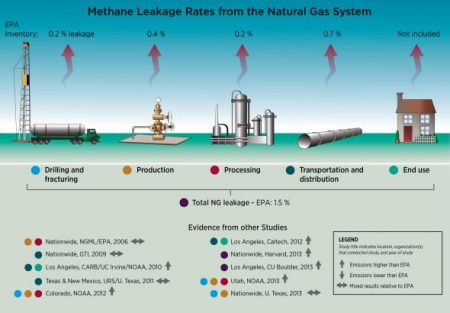June 22, 2018 – It really shouldn’t come as a surprise that the administration led by Donald Trump is lying about methane emissions coming from U.S. oil and natural gas sources. In a revealing report published in the journal AAAS/Science, a team of scientists and researchers from the University of Texas at Austin, Penn State, Stanford, Harvard, University of Michigan, Washington State, Colorado State, Princeton, University of Colorado, Carnegie Mellon, Purdue, University of Cincinnati, NOAA, and the Environmental Defense Fund, using a variety of measuring technologies and sources, both top-down (aerial sniffing) and bottom-up (at the wellhead and in transportation and storage), found that methane (CH4) is leaking into the atmosphere at a much higher rate than EPA estimates.
CH4 is a more potent greenhouse gas than carbon dioxide (CO2) although its longevity is short-lived when compared to the latter. Where CH4’s greenhouse impact lasts between 10 and 20 years, CO2’s lasts for centuries. The fact that there is more CH4 leaking into the atmosphere from U.S. oil and natural gas operations shouldn’t be a surprise considering the expansion in hydraulic fracturing (fracking) by American energy companies. This has led to a significant growth in oil and natural gas output. It was expected, with such growth in production that escaped CH4 levels would rise and the EPA established emission inventory methods to track it. Unfortunately, the EPA has gotten it wrong.
The emissions described in this report aren’t those created by the burning of the fossil fuels, but rather, from leaks at the wellhead and throughout the supply chain. The researchers report their findings with a high degree of confidence that EPA estimates are currently way off the mark. They believe this is so because the EPA based its estimates on the sampling of conventional fracking operations rather than abnormal operating conditions which exist at many U.S. sites. These abnormal conditions have been observed in significant quantity throughout exploration, production, transportation and storage of both oil and natural gas. At 20% of storage sites, in fact, CH4 emissions are occurring at a rate four times higher than EPA estimates.
It would behoove the EPA, even under Scott Pruitt, to get its methodology and facts straight. The oil and natural gas industry is the leading source of CH4 emissions in the United States. And contrary to popular opinion, produces far more than cow farts or landfill leaks. With no guarantee that the EPA intends to correct its mistakes on CH4 emissions tracking, there is no way to know how much the additional underestimated greenhouse gas is contributing to climate change.
And maybe that’s the point of it all. If you pretend it is not there then you can deny the problem exists.
The EPA, as of yet, has not called into question or responded to the report published this month. But one would think that the remaining well-meaning scientists at the EPA will take a look at the research teams’ methodology and its conclusions which state that CH4 emissions may be even higher than the data they have gathered.
This research report is one of 33 peer-reviewed papers associated with 16 different research projects, all published in academic journals. Funding of the studies has come from the Environmental Defense Fund, a number of foundations, and the natural gas industry itself.
The final analysis in this report states that EPA current estimates of CH4 emissions from oil and gas operations. somewhere between 1.3 and 1.6% of the total volume produced by the industry is off by as much as 53%. The actual number is 2% or higher. The 2% over the 1.3 to 1.6% translates to 10 million additional metric tons of CH4 leaking from U.S. operations annually or equivalent tp not accounting for the running of more than 200 coal-fired power plants in the country year round.









